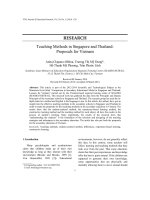TEACHING METHOD
Bạn đang xem bản rút gọn của tài liệu. Xem và tải ngay bản đầy đủ của tài liệu tại đây (534.46 KB, 50 trang )
teaching methodology
Outline:
•
Communicative language teaching (CLT)
•
Presentation, practice, and production (PPP)
•
Task-based learning (TBL)
•
The structural – situational method
COMMUNICATIVE LANGUAGE TEACHING (CLT)
1. Definition
❖ The Communicative Language Teaching (CLT) started its rise to prominence during the 1970s and 80s.
❖ CLT aims broadly to make communicative competence the goal of language teaching.
❖ Providing students with real-life communication lessons that try to mimic the natural progression of
language learning.
COMMUNICATIVE LANGUAGE TEACHING (CLT)
2. Roles
❖ Role of the teacher:
The teacher facilitates communication
As an advisor and a guide
→ Promote communication.
→ answering Ss’ questions and monitoring their
performance.
COMMUNICATIVE LANGUAGE TEACHING (CLT)
2. Roles
❖ Role of the students:
Ss are communicators. They are actively
Ss are expected to interact primarily with
engaged in trying to make themselves
each other than with the teacher.
understood.
• The
mea
ningf
ulne
ss
• princ
The
•
task
iple
The
princ
com
iple
muni
catio
n
princ
3. Principles
iple
COMMUNICATIVE LANGUAGE TEACHING (CLT)
COMMUNICATIVE LANGUAGE TEACHING (CLT)
3. Principles
1.
The primary function of language is for
interaction and communication
2.
The activities that truly communicative
have features of information gap, choice,
and feedback
COMMUNICATIVE LANGUAGE TEACHING (CLT)
3. Principles
3.
Ss – Ts interaction: The facilitator of the
4.
Ss – Ss interaction: They do in various
activities, present some part of the lesson.
configurations: pairs, triads, small group, and
Sometimes he is a co-communicator
whole group
COMMUNICATIVE LANGUAGE TEACHING (CLT)
4. Emphasis
Language functions might be emphasized over forms.
Areas
of
Students work with language at the discourse or
suprasentential level.
Language
Learn about cohesion and coherence.
COMMUNICATIVE LANGUAGE TEACHING (CLT)
4. Emphasis
Oral communication
Reading the article
Skills
are emphasized
Listening
Speaking
COMMUNICATIVE LANGUAGE TEACHING (CLT)
5. Techniques
5.1 Authentic materials
•
In order to transfer what Ss learn to the outside world and to expose students to natural language in a
variety of situations
•
Use newspaper article and assign the Ss homework
→ Suitable for a high-intermediate level of proficiency
COMMUNICATIVE LANGUAGE TEACHING (CLT)
5. Techniques
5.2 Scrambled Sentences
•
The Ss are given a passage (a text) to unscramble the sentences or the lines of a mixed-up dialogue to
their original order.
→ Teaches Ss about the cohesion and coherence properties of language
COMMUNICATIVE LANGUAGE TEACHING (CLT)
5. Techniques
5.3 Language Games
•
Ts show the first picture of the story
•
Information gap, choice, feedback
→ Using a problem-solving task as a communicative technique
COMMUNICATIVE LANGUAGE TEACHING (CLT)
5. Techniques
5.4 Role-play
Give Ss an opportunity to practice communicating in different social contexts and in different social roles.
COMMUNICATIVE LANGUAGE TEACHING (CLT)
6. Conclusion
✓
To increase the communicative skills in a second language of the Ss by
representing a common situation.
✓
To make a more effective lesson, where practicing the main vocabulary and
expressions proposed are the most important purposes.
✓
To create a relaxed environment where we know each other and where
everybody feels part of the class.
Presentation; practice; production(PPP)
Presenter :
Presentation; practice; production(PPP)
1.
Definition : PPP is an orderly system that helps define the way instruction occurs. It is a method
for teaching structure. PPP is divided into 3 stages :
Presentation
Practice
Production
Presentation; practice; production (PPP)
PRESENTATION
•
•
Introduce the material and explain it.
Present through demonstration or modeling.
PRATICE
•
•
Give Ss opportunities to apply new language with guidance and support.
Ss practice smaller parts or segments of the new material.
PRODUCTION
•
Encourage Ss to demonstrate use of the new language in context through activities or projects they complete
with minimal Ts assistance.
•
Practice the
language using
accurate
reproduction
•
techniques.
Students
Use the new
language, make
sentences of their
own.
•
Introduces a
situation which
contextualizes the
Teacher
language to be
•
taught.
Presents the
language.
2. Roles
3. Principles
What happens during the presentation stage?
• Presentation stage is controlled by the teacher.
• The teacher use a text, an audiotape or visual aids to demonstrate a situation.
• She will extract the required language forms.
• She writes the language forms and describes it.
3. Principles
What happens during the practice stage?
• Students practice saying or writing the language structure correctly.
• Practice activities: drills, multiple-choice exercise, gap-and-cue exercises, transformations and so on.
• Teacher directs the activities to provide positive feedback to students.
• Teacher correct mistakes and model the correct forms.
3. Principles
What happens during the production stage?
• Ss use the newly learned language structure to produce oral or written texts.
• Production activities: dialogues, oral presentation and the production of sentences, paragraphs, or
longer texts .
• Ts doesn’t correct on this stage.
• If Ss make mistake, they are pointed out after the exercise has finished.
4. Focus/emphasis
Focus on forms lesson, especially at lower levels.
Teach grammar points
5. Some techniques
Choral repetition
Individual repetition
• Ss repeat a words, phrase
• Individual Ss repeat a word,
Cue-response drills
• The Ts give a cue
or sentence all together
phrase or sentence at the
nominates a Ss and the Ss
with the Ts “conducting”.
Teacher’s urging.
make the desired
response .









